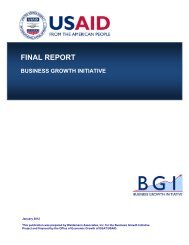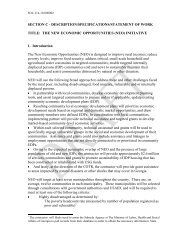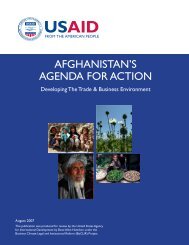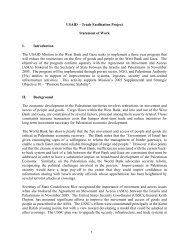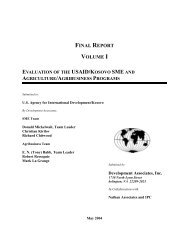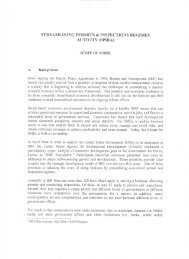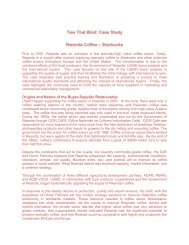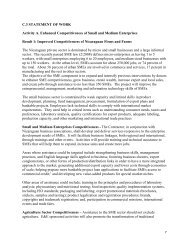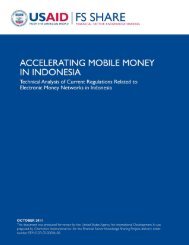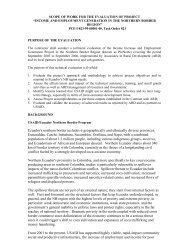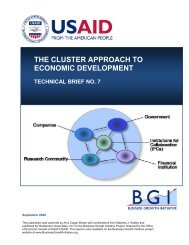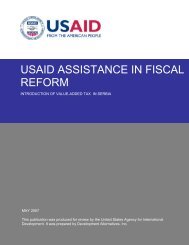Trade and Commercial Law Assessment - Honduras - Economic ...
Trade and Commercial Law Assessment - Honduras - Economic ...
Trade and Commercial Law Assessment - Honduras - Economic ...
Create successful ePaper yourself
Turn your PDF publications into a flip-book with our unique Google optimized e-Paper software.
TRADE AND COMMERCIAL LAW ASSESSMENT DECEMBER 2004HONDURASarea of the world in which they are to be applied; in the case of the TCLA, the CLIRmethodology was adopted to better fit the Central American legal context, as opposed to that ofEastern Europe, for example, where the methodology was originally applied.In addition, new areas of law continue to be added to the methodology. Along with the firstapplication of <strong>Trade</strong>Stream, TCLA saw the further development <strong>and</strong> application of the newestCLIR section, Financial Crimes, which focuses primarily on those issues surrounding terroristfinancing <strong>and</strong> money laundering, <strong>and</strong> have become more relevant in the wake of September 11,2001.2. Scope of the MethodologyThe diagnostic assessment was designed to help USAID missions, the countries themselves, <strong>and</strong>other donors, achieve the following objectives:♦♦♦To provide a factual basis for characterizing the degree of development <strong>and</strong> the status oftrade commercial law reforms in a country;To provide a methodologically consistent foundation for identifying <strong>and</strong> describing theroot causes of the "implementation/enforcement" gap among the CAFTA countries; <strong>and</strong>To provide analytical <strong>and</strong> planning tools <strong>and</strong> metrics that will help USAID, the countriesthemselves, as well as other donors to design new approaches to sustainable, costeffectiveinterventions <strong>and</strong> reform programs.While the subject matter areas have varied from country to country, for the purposes the TCLA,"commercial law" <strong>and</strong> CLIR is defined to include the following substantive legal areas:♦♦♦♦♦♦♦Bankruptcy. Mechanisms intended to facilitate orderly market exit, liquidation ofoutst<strong>and</strong>ing financial claims on assets, <strong>and</strong> rehabilitation of insolvent debtorsCollateral. <strong>Law</strong>s, procedures, <strong>and</strong> institutions designed to facilitate commerce bypromoting transparency, predictability, <strong>and</strong> simplicity in creating, identifying, <strong>and</strong>extinguishing security interests in assets<strong>Commercial</strong> Dispute Resolution. <strong>Law</strong>s, procedures, <strong>and</strong> institutions relating to thesettlement of commercial disputes, whether through courts or alternative disputeresolution mechanisms, <strong>and</strong> the enforcement of judgments <strong>and</strong> decreesCompany <strong>Law</strong>. Legal regimes for market entry <strong>and</strong> operation that define norms fororganization of formal commercial activities conducted by two or more individualsCompetition. Rules, policies, <strong>and</strong> supporting institutions intended to help promote <strong>and</strong>protect open, fair, <strong>and</strong> economically efficient competition in the market, <strong>and</strong> for themarketContract. The legal regime <strong>and</strong> institutional framework for the creation, interpretation,<strong>and</strong> enforcement of commercial obligations between one or more parties.Financial Crimes. The legal regime, institutional infrastructure, <strong>and</strong> methods ofinternational cooperation employed to prevent the financing of terrorist activities <strong>and</strong>laundering of criminal assets.I-3



